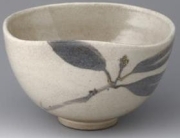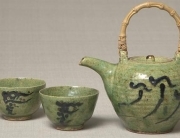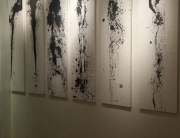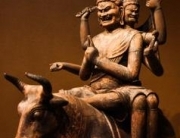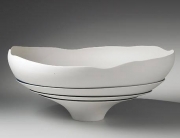The National Museum of Modern Art in Kyoto decided to celebrate the 50th anniversary of the founding of the Japanese Cultural Institute in Rome. To do so they put together an incredible exhibition of 170 nihonga paintings and other decorative art pieces. The event also celebrated the 400th anniversary of the founding of the first official Japanese embassy in that city.
Due to concerns about museum conservation, curators Matsubara Ryuichi and Ozaki Masaaki staged the event in two separate stages. This allowed them to substitute the works on silk and paper with examples from the same artists. The first segment of the exhibition was held until March 31st. The second was held between April 4th and May 5th.

“Ripples” by Fukuda Heihachiro was completed in 1932. It is a minimalist painting done in the Nihonga style. Photo Credit: Osaka City Museum of Modern Art by way of the New York Times
During the period of isolation, Japanese artists were exposed to Chinese and European pieces through ships at the port of Nagasaki. When the Meiji restoration occurred, a good deal of Japanese artistry split into two separate schools of thought. Nihonga artists continued to use Japanese materials even after Japan could import products from all around the world.
These artists aren’t represented very well in international collections. Therefore, this exhibition was really exciting. Visitors to the National Gallery of Modern Art in Rome who got to see the pieces were particularly interested in “Ripples” by Fukuda Heihachiro.
The piece is extremely bold in its minimalist pallet. It’s almost completely abstract in style. While it is certainly in keeping with traditional Japanese sensibilities, when “Ripples” was completed in 1932 it certainly had a particularly modern appearance.
Contemporary art styles were becoming increasingly popular and that meant that increasing levels of abstractions were acceptable. Yokoyama Taikan’s “Waterfall” was finished around 1900. It shows far less abstraction than later pieces do. In fact, it almost resembles a pleasant Chinese landscape painting.

Yokoyama Taikan’s “Waterfall” was completed around 1900 and looks to be harmoniously traditional. Photo Credit: Aichi Prefectural Museum of Art and the New York Times
When foreign advisers came to Japan during the Meiji era, an American named Ernest Francisco Fenollosa came with them. While originally came to lecture on politics on philosophy Fenollosa fell in love with Japanese visual arts. He feared that in the rush to modernize the country Japan would loose many of its traditions, so he actively encouraged the training of Nihonga style painters. That allowed Japanese artists to preserve many of the techniques that would have otherwise been forgotten about.
A brilliant student named Okakura Kakuzo was right along side him, and worked to found the Kanga Association. Later he presided over the Tokyo Art Institute and established the Japanese Art Academy.


